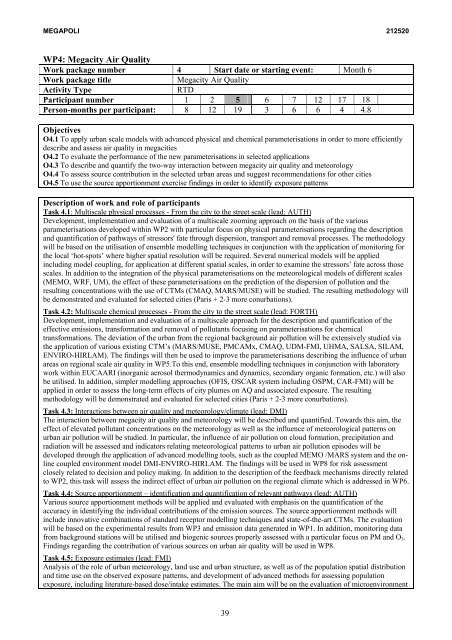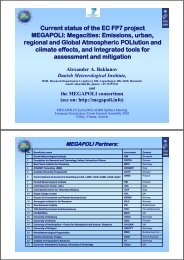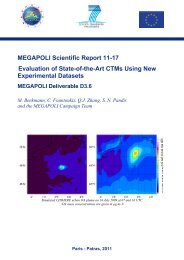D E S C R I P T I O N O F W O R K - MEGAPOLI - Dmi
D E S C R I P T I O N O F W O R K - MEGAPOLI - Dmi
D E S C R I P T I O N O F W O R K - MEGAPOLI - Dmi
Create successful ePaper yourself
Turn your PDF publications into a flip-book with our unique Google optimized e-Paper software.
<strong>MEGAPOLI</strong> 212520<br />
WP4: Megacity Air Quality<br />
Work package number 4 Start date or starting event: Month 6<br />
Work package title Megacity Air Quality<br />
Activity Type RTD<br />
Participant number 1 2 5 6 7 12 17 18<br />
Person-months per participant: 8 12 19 3 6 6 4 4.8<br />
Objectives<br />
O4.1 To apply urban scale models with advanced physical and chemical parameterisations in order to more efficiently<br />
describe and assess air quality in megacities<br />
O4.2 To evaluate the performance of the new parameterisations in selected applications<br />
O4.3 To describe and quantify the two-way interaction between megacity air quality and meteorology<br />
O4.4 To assess source contribution in the selected urban areas and suggest recommendations for other cities<br />
O4.5 To use the source apportionment exercise findings in order to identify exposure patterns<br />
Description of work and role of participants<br />
Task 4.1: Multiscale physical processes - From the city to the street scale (lead: AUTH)<br />
Development, implementation and evaluation of a multiscale zooming approach on the basis of the various<br />
parameterisations developed within WP2 with particular focus on physical parameterisations regarding the description<br />
and quantification of pathways of stressors' fate through dispersion, transport and removal processes. The methodology<br />
will be based on the utilisation of ensemble modelling techniques in conjunction with the application of monitoring for<br />
the local ‘hot-spots’ where higher spatial resolution will be required. Several numerical models will be applied<br />
including model coupling, for application at different spatial scales, in order to examine the stressors’ fate across those<br />
scales. In addition to the integration of the physical parameterisations on the meteorological models of different scales<br />
(MEMO, WRF, UM), the effect of these parameterisations on the prediction of the dispersion of pollution and the<br />
resulting concentrations with the use of CTMs (CMAQ, MARS/MUSE) will be studied. The resulting methodology will<br />
be demonstrated and evaluated for selected cities (Paris + 2-3 more conurbations).<br />
Task 4.2: Multiscale chemical processes - From the city to the street scale (lead: FORTH)<br />
Development, implementation and evaluation of a multiscale approach for the description and quantification of the<br />
effective emissions, transformation and removal of pollutants focusing on parameterisations for chemical<br />
transformations. The deviation of the urban from the regional background air pollution will be extensively studied via<br />
the application of various existing CTM’s (MARS/MUSE, PMCAMx, CMAQ, UDM-FMI, UHMA, SALSA, SILAM,<br />
ENVIRO-HIRLAM). The findings will then be used to improve the parameterisations describing the influence of urban<br />
areas on regional scale air quality in WP5.To this end, ensemble modelling techniques in conjunction with laboratory<br />
work within EUCAARI (inorganic aerosol thermodynamics and dynamics, secondary organic formation, etc.) will also<br />
be utilised. In addition, simpler modelling approaches (OFIS, OSCAR system including OSPM, CAR-FMI) will be<br />
applied in order to assess the long-term effects of city plumes on AQ and associated exposure. The resulting<br />
methodology will be demonstrated and evaluated for selected cities (Paris + 2-3 more conurbations).<br />
Task 4.3: Interactions between air quality and meteorology/climate (lead: DMI)<br />
The interaction between megacity air quality and meteorology will be described and quantified. Towards this aim, the<br />
effect of elevated pollutant concentrations on the meteorology as well as the influence of meteorological patterns on<br />
urban air pollution will be studied. In particular, the influence of air pollution on cloud formation, precipitation and<br />
radiation will be assessed and indicators relating meteorological patterns to urban air pollution episodes will be<br />
developed through the application of advanced modelling tools, such as the coupled MEMO /MARS system and the online<br />
coupled environment model DMI-ENVIRO-HIRLAM. The findings will be used in WP8 for risk assessment<br />
closely related to decision and policy making. In addition to the description of the feedback mechanisms directly related<br />
to WP2, this task will assess the indirect effect of urban air pollution on the regional climate which is addressed in WP6.<br />
Task 4.4: Source apportionment – identification and quantification of relevant pathways (lead: AUTH)<br />
Various source apportionment methods will be applied and evaluated with emphasis on the quantification of the<br />
accuracy in identifying the individual contributions of the emission sources. The source apportionment methods will<br />
include innovative combinations of standard receptor modelling techniques and state-of-the-art CTMs. The evaluation<br />
will be based on the experimental results from WP3 and emission data generated in WP1. In addition, monitoring data<br />
from background stations will be utilised and biogenic sources properly assessed with a particular focus on PM and O3.<br />
Findings regarding the contribution of various sources on urban air quality will be used in WP8.<br />
Task 4.5: Exposure estimates (lead: FMI)<br />
Analysis of the role of urban meteorology, land use and urban structure, as well as of the population spatial distribution<br />
and time use on the observed exposure patterns, and development of advanced methods for assessing population<br />
exposure, including literature-based dose/intake estimates. The main aim will be on the evaluation of microenvironment<br />
39




